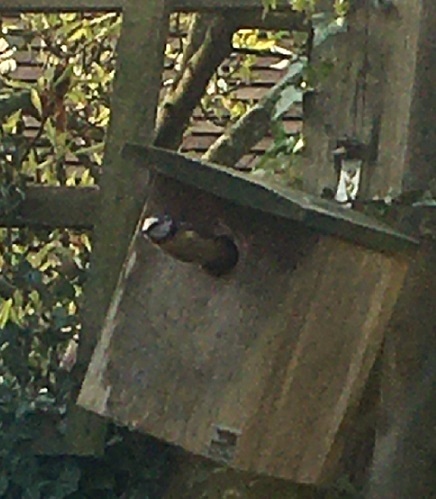
This nest box, just outside our conservatory, had Blue Tits nesting in it in 2016, and Tree Bumblebees in 2017, and nothing in 2018 and 2019, but Blue Tits are back this year.

They’ve been carrying huge beakfuls of moss and a few feathers into the nestbox for days. I guess the female has just started or is about to start laying a clutch of about 9 eggs, one a day, which will then take 14 days to incubate and so we should see feeding visits to nestlings starting on about 5 May.
What will our world be like then?
This BTO webpage is a useful source of all sorts of informaton about bird biology, species by species, including their laying dates.
From there you can find the range of first egg dates (excluding extremes) for a range of fairly common UK breeding birds (although the dates given refer mostly to England since that is where most of the data derive). How do my Blue Tits measure up:
Woodpigeon – 22 Feb
Jackdaw – 12 Mar
Mistle Thrush – 17 Mar
Robin – 19 Mar
Song Thrush – 21 Mar
Blackbird – 22 Mar
Long-tailed Tit – 24 Mar
Dunnock – 1 April
Treecreeper – 5 Apr
Starling – 6 April
Stock Dove – 6 Apr
Great Tit – 10 April
Blue Tit – 12 April
Chaffinch – 12 April
Wren – 14 April
The figures above look like they are a useful guide to laying dates.
My Blue Tits, if they are on eggs today, are pretty early Blue Tits, but then they have been stuffing themselves on sunflower seeds all winter at my expense.
What these dates mean is that any substantial tree felling at this time of year, whether it be for HS2 or to create a harvest of timber in commercial forestry, is likely, quite likely, to be killing nesting birds. That’s something to think about.
Indeed, people have thought about it in the past, and they’ve banned hedge trimming and suchlike operations from 1 March – 31 August as a condition of receiving agricultural grants and subsidies.
But those regulations which apply to farmers and farm operations do not appear to apply to foresters. Here is some rather old (but still appearing prominently on the internet) advice by Natural England.
The whole area of protecting birds’ nests from destruction in the breeding season is an interesting one – well, it is interesting me.
[registration_form]
Hi Mark,
yep, most Blue tits are pretty synchronised with their breeding, as they need to time the 2 1/2 weeks of feeding the young with the peak of caterpillars on young tree leaves…….But interestingly, our pair at home are as early as ever… 4 eggs already, but the pair at work (we have a public webcam here: https://www.bas.ac.uk/project/biodiversity_bas_cambridge/#data so anyone can watch – we will switch to kestrels later in the season) are only lining, which is about right for most blue and great tits right now, including our garden Great tits. enjoy checking into the webcam whenever, and why not consider contributing your nest box data to the BTO’s Nest records scheme (which is currently limited to nest recording from home till we can all get out more!)
Not checked my boxes yet, I rarely do until the Pied Flycatchers are back and building. I’m hopeful the Treecreepers are in their box, they missed last year. I know I have Blue and Great Tits in some boxes am hopeful for one of our two pairs of Nuthatch to be in a box in the first time for a year or two ( a favourite hole is no longer as the branch blew down). As long as there are empty boxes for the flycatchers and Redstarts. Nest boxes allow a fascinating insight into the breeding lives of birds, in this period of lockdown we should all pay more attention to them.
And a Goldfinch in a Bay tree